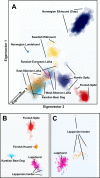Origins and wanderings of the Finnish hunting spitzes
- PMID: 29958296
- PMCID: PMC6025854
- DOI: 10.1371/journal.pone.0199992
Origins and wanderings of the Finnish hunting spitzes
Abstract
Deducing the evolutionary histories of dog breeds can be challenging due to convergent traits and frequent admixture. In this report, we have explored the relationships of indigenous Finnish hunting spitz breeds among other northern Eurasian hunting breeds using commercially available SNP analysis (the MyDogDNA panel test). We find that Nordic hunting breeds Finnish Spitz, Nordic Spitz and the Karelian Bear Dog, as well as the reindeer herding Lapphund and Lapponian herder are all closely related and have common origins with the northeastern Eurasian Laika breeds, rather than with other Scandinavian Spitz breeds, such as Elkhounds and Swedish Vallhund. By tracing admixture events and direction of gene flow, we also elucidate the complex interactions between the breeds and provide new insight into the history of Swedish Elkhound and Russian-European Laika. The findings, together with an analysis of genetic differentiation between the populations, not only help to understand the origins of the breeds but also provide interesting possibilities to revive genetic diversity, lost during the breeding history, by backcrossing breeds to their hypothetical ancestry.
Conflict of interest statement
HA and JD represent Genoscoper Laboratories Ltd, a private company providing dog genotyping services. This affiliation does not alter the authors' adherence to PLOS ONE policies on sharing data and materials. HA and JD also do not financially benefit from marketing the product(s) that is/are related to this research.
Figures






Similar articles
-
Founder representation and effective population size in old versus young breeds-genetic diversity of Finnish and Nordic Spitz.J Anim Breed Genet. 2017 Oct;134(5):422-433. doi: 10.1111/jbg.12262. Epub 2017 Mar 10. J Anim Breed Genet. 2017. PMID: 28295678
-
Historic dog Furs Unravel the Origin and Artificial Selection of Modern Nordic Lapphund and Elkhound dog Breeds.Mol Biol Evol. 2024 Jul 3;41(7):msae108. doi: 10.1093/molbev/msae108. Mol Biol Evol. 2024. PMID: 38842255 Free PMC article.
-
Regional occurrence, high frequency but low diversity of mitochondrial DNA haplogroup d1 suggests a recent dog-wolf hybridization in Scandinavia.Anim Genet. 2011 Feb;42(1):100-3. doi: 10.1111/j.1365-2052.2010.02069.x. Anim Genet. 2011. PMID: 20497152 Free PMC article.
-
[Breeding of the Russian sable: Stages of industrial domestication and genetic variability].Genetika. 2016 Sep;52(9):1001-11. Genetika. 2016. PMID: 29369555 Review. Russian.
-
Canine behavioral genetics: pointing out the phenotypes and herding up the genes.Am J Hum Genet. 2008 Jan;82(1):10-8. doi: 10.1016/j.ajhg.2007.12.001. Am J Hum Genet. 2008. PMID: 18179880 Free PMC article. Review.
Cited by
-
Genetic prevalence and clinical relevance of canine Mendelian disease variants in over one million dogs.PLoS Genet. 2023 Feb 27;19(2):e1010651. doi: 10.1371/journal.pgen.1010651. eCollection 2023 Feb. PLoS Genet. 2023. PMID: 36848397 Free PMC article.
-
True Colors: Commercially-acquired morphological genotypes reveal hidden allele variation among dog breeds, informing both trait ancestry and breed potential.PLoS One. 2019 Oct 28;14(10):e0223995. doi: 10.1371/journal.pone.0223995. eCollection 2019. PLoS One. 2019. PMID: 31658272 Free PMC article.
-
Variation in breeding practices and geographic isolation drive subpopulation differentiation, contributing to the loss of genetic diversity within dog breed lineages.Canine Med Genet. 2020 Jun 9;7:5. doi: 10.1186/s40575-020-00085-9. eCollection 2020. Canine Med Genet. 2020. PMID: 32835230 Free PMC article.
References
-
- Larson G, Karlsson EK, Perri A, Webster MT, Ho SY, et al. (2012) Rethinking dog domestication by integrating genetics, archeology, and biogeography. Proc Natl Acad Sci U S A 109: 8878–8883. doi: 10.1073/pnas.1203005109 - DOI - PMC - PubMed
-
- Wayne RK, vonHoldt BM (2012) Evolutionary genomics of dog domestication. Mamm Genome 23: 3–18. doi: 10.1007/s00335-011-9386-7 - DOI - PubMed
-
- Kumpulainen M, Anderson H, Svevar T, Kangasvuo I, Donner J, et al. (2017) Founder representation and effective population size in old versus young breeds-genetic diversity of Finnish and Nordic Spitz. J Anim Breed Genet. - PubMed
-
- Simonlinna J (1990) Suomenpystykorva 100 vuotta—Tiististä kansalliskoiraksi [Finnish Spitz 100 years—from "Tiisti" to the national dog In Finnish.]. Valkeala, Finland: Suomen Pystykorvajärjestö r.y. 220 p.
-
- Palo JU, Ulmanen I, Lukka M, Ellonen P, Sajantila A (2009) Genetic markers and population history: Finland revisited. Eur J Hum Genet 17: 1336–1346. doi: 10.1038/ejhg.2009.53 - DOI - PMC - PubMed
Publication types
MeSH terms
LinkOut - more resources
Full Text Sources
Other Literature Sources

